#redbud roots
Text

Cartridges
#distalate cartridges#live resin carts#cannabis#420#element#stiiizy#canna breeze#MKX#redbud roots#smoke weed everyday#stoner
45 notes
·
View notes
Text
Podcast crossover alert!!! Remember Em, our season three premiere guest on #LoveThisThingCast? She invited Sophie to be a guest on HER podcast, Rooted! Tune in on Apple Podcasts, Spotify, the link above, or wherever you listen to podcasts.
#lovethisthingcast#podcast#podcasts#positivity#love#throuthewindow#rooted#plant history#plants#trees#redbud tree#redbud
2 notes
·
View notes
Text
I just yanked up a bunch of invasive honeysuckle from my front garden
It'll probably come back but
That might slow the spread a bit
#its slowly started encroaching on the front of the house#it was just in the back#i also have the american sycamore and the baby redbud in a pot now#the elm was gonna be too tricky i think#also im not 100% sure its an elm otherwise i mightve tried to go for it anyway#im gonna get one of the little pines too#im hoping i didnt cut the tap roots too high up. im pretty sure i got to the very ends#but theres A LOT of roots in that garden to a lot of different trees and other plants#and its kinda hard to tell whats what#thats why my mom doesnt plant in that garden#there was like ONE rose growing out there when we moved in#thats literally it tho#the honeysuckle likes it but that shit will grow anywhere#lots of little trees but i started noticing them back in 2020 at least and they havent gotten very big#the dirt is super hard and dry and full of clay and rocks#HOWEVER#some violets have started to grow (the leaves have at the very least)#which is reassuring#and we have what looks like virginia creeper#and i might try to take a cutting of that and propagate it#surprisingly considering evem dandelions dont grow very well in the garden lol#like i dont know what the previous owners of this house did to that garden but it is where plants go to die#my mom planted some stuff that was supposed to come back every year and get pretty big. it did not#some of its still out there but its just gotten smaller and smaller every year
1 note
·
View note
Text


Some time ago, a mysterious flower appeared in Ebott. It wasn't a monster, let alone a human, and no one knows for sure where it came from. The tiny flower can be seen wandering around from time to time, and many monsters fear it and keep their distance. Some are even a little aggressive, believing it to be bad luck, but it doesn't seem to be anything to worry about.
Despite being the best place to disguise, Flowey tends to avoid Redbud Gardens. These flowers have long and sprawling roots, which end up being a big trap for him, and he always ends up trapped.
Sometimes he seems to know more than he thinks.
if this has any grammar mistakes or whatever, let me know and I'll fix it 😑👍
39 notes
·
View notes
Text
not to be overly sappy and emotional on main but i was getting ready to have a perfectly miserable day and then read a poem that turned that around for me so i’ll post it here just in case someone else could also use the help
Reasons to Live by Ruth Awad
Because if you can survive
the violet night, you can survive
the next, and the fig tree will ache
with sweetness for you in sunlight that arrives
first at your window, quietly pawing
even when you can’t stand it,
and you’ll heavy the whining floorboards
of the house you filled with animals
as hurt and lost as you, and the bearded irises will form
fully in their roots, their golden manes
swaying with the want of spring—
live, live, live, live!—
one day you’ll put your hands in the earth
and understand an afterlife isn’t promised,
but the spray of scorpion grass keeps growing,
and the dogs will sing their whole bodies
in praise of you, and the redbuds will lay
down their pink crowns, and the rivers
will set their stones and ribbons
at your door if only
you’ll let the world
soften you with its touching.
#revised plan for today is now to 1 reach out to a friend 2 go outside 3 buy a book and read it all the way through in one sitting#hope we’re all doing well today. much love x
40 notes
·
View notes
Text
If you're wondering what we ARE going to do about all that poison ivy, and the general absolute shittiness of our fields, and for that matter what the fuck two people with no farming background and like...more than full-time work already are going to do with like sixteen acres of field anyway....we don't know.
Don't get me wrong, we have a lot of ideas. Most of which we either can't currently afford or for some other reason can't achieve. But some of which are lovely.
Rotational grazing, especially the high-density, frequently moved version sometimes known as "mob grazing", would eventually fix a lot of what's wrong with those fields. But not without way more animals than we have or even intend to have. We don't even have a "mob" TO graze. The sheep will eat some poison ivy, though it's not their favorite. They'll eat the leaves off the brambles, which is a pretty effective way to deplete the plant's stores and stunt it. They won't eat the Virginia Creeper.
But in a way, it doesn't matter, because we've spent nearly the entire last year moving the ewes through the smaller of the two fields, and they're only just getting back to where they started. In order to make a serious impact, they'd need to be grazing the same spot maybe every two months, depending on weather conditions. Not once a year. As I showed in a previous video, everywhere they go, they do visibly leave nitrogen, and we can actually see a slight improvement everywhere they've passed through. But it's not fast. And getting and caring for the...I don't know, fifty or so? sheep that would speed the process would make moving and caring for those sheep a full-time job neither of us has the capacity for. It's just not even an intention of ours. We've never really discussed a "cap", but I'd say that a "someday when we have real fencing and I'm healthy" number of sheep would still be twenty or thirty at the most.
The conventional, and arguable still best, way to fix the big field and its extreme fuckery would be to till and reseed. It would, believe it or not, still not eliminate all of the problem weeds, especially not the Virginia Creeper and Canada Thistle (which loves to grow back from root fragments and is resistant to normal herbicides). But it would be a huge start. We'd seed with a pasture mix that's full of plants that can handle being grazed down, and then mow where the sheep don't get to. I don't even know what it would cost to hire out all that work or rent the tools, but it's more than we have. It's like asking what it would cost to replace the siding on your house. I don't know, but I know I aint got it.
So for now, Jacob is spending a lot of hours just mowing. Mowing doesn't do as much as grazing, notably it doesn't leave nitrogen, but it does ensure that light is hitting the soil so that seeds there can sprout, and it does give the advantage to plants adapted for grazing (mainly grasses).
Eventually, the plan is to reforest several acres of the big field, using government programs. That also comes with the need to control understory growth for years until the trees mature enough to shade things out, but actually, help with that is part of some of the programs. They typically plant with a mix of natives--oak, tulip poplar, redbud...the mix varies based on what the contracted companies grew that year, apparently, but it's not really something you get to pick and choose. They come, they calculate their grid, they plant. But I don't think anything's to stop you coming through afterwards and planting your own selections in spots where saplings inevitably die. Pawpaw, white oak, American persimmon, hybrid chestnut... I dream of a day where we have maybe ten acres of forest, where I can harvest mushrooms and chestnuts, paw paws and berries and ginseng. Where the boy can bag us a wild turkey for holiday dinner or supplement the freezer with deer that got fat on fall acorns.
In my wildest fantasies (and, to be fair, what I have now was once my wildest fantasies!), the "small" field is an intercropped quilt of coppiced willow and locust, berry bushes, broad stripes of sorghum, amaranth, corn, and wheat for people and animals, strips of wildflower meadow to make corridors for animals and beneficial insects, and large patches of medicinal herbs and dye plants. The "north" field, the one that is so especially troubled now, is part forest, part pasture, with permanent perimeter fences, a loose scattering of trees that provide shade and fodder, and sheep being guided through the larger perimeter with portable electric mesh fencing.
So that's what we (very sarcastically) refer to as the "five year plan" here. But I'm trying to learn not to hamstring us with doubt and disbelief, so....that's the plan.
21 notes
·
View notes
Note
do you know how much of a root ball should be dug out for transplanting a 2-foot tall volunteer redbud tree, or someone who does?
I do not. Anyone here have an answer?
191 notes
·
View notes
Text
Excerpt from this story from The Revelator:
Last summer I took advantage of my break from teaching by enjoying long, daily walks around my neighborhood. I indulged my mind and body in the blueness, stillness, and leafiness that is North Carolina in June and July. It’s truly astounding how many leaves a willow oak can cram into one tiny piece of sky.
On my walks, the yard of one house stuck out. It was unlike any yard I’ve seen around my city or in any of the other cities in the United States, Canada, and Australia where I’ve lived. It is a forest yard. Nearly a dozen large trees are interspersed amid a dense stand of saplings and shrubs. That summer, leaf litter covered the ground. The top of the house was only visible if I craned my neck to see down the paved driveway, itself narrowing and crumbling as roots, lichens, and fungi worked their inexorable magic.
Depending on your perspective, the house with the forest yard could be seen either as an eyesore — and the scariest place to trick-or-treat — or, as in my case, the most splendid place imaginable.
At this point, I should probably mention that I’m an urban ecologist and that the forest yard makes my heart flutter at the possibility and hope of nature in cities.
I looked at aerial images for the area, and they revealed that the trees around that home, which haven’t been actively “managed,” are about 50 years old. Over that time the forest yard has accumulated a bewildering array of species and ecological interactions. Its tulip poplars, walnuts, cedars, redbuds, pines, and willow oaks have soaked up the atmosphere’s carbon dioxide and turned it into much-needed habitat for wildlife: butterflies, bees, and other insects; lizards, snakes, and turtles; frogs and toads; birds; and mammals. It’s home to a multitude of soil invertebrates and fungi that keep the business side of an ecosystem — aka decomposition — going. All the species that share this shady third-of-an-acre lot are intertwined in a complex tangle of relationships that keeps them fed and feeding on one another, interdependent to varying degrees for their life and livelihood.
And all of this exists amidst a matrix of roads, single-family and multiplex housing, commercial plazas, light industry, and high rises that make up a medium-sized city in the Southeast. The forest yard is a little island of nature in a nearly lifeless sea of concrete, asphalt and lawn.
But, to my inexhaustible surprise, that sea of concrete, asphalt, and lawn is not as empty as we tend to assume. Very far from it. Places of dense human habitation are also where many species reside, including some that are threatened. A recent analysis of the birds and plants that occur in 147 cities across the globe revealed that the sampled cities were home to 2,041 bird species — about one-fifth of Earth’s total avian diversity — and 14,240 plant species. These include 36 bird and 65 plant species threatened with global extinction.
To get a better idea of just how much of the urban biodiversity iceberg lies below the surface of our awareness, consider this: Last year participants in the City Nature Challenge made nearly 1.9 million observations in 480 cities, with the residents of the La Paz metropolitan area in Bolivia recording the high score of 5,320 species.
Add to this the estimate that we share our homes and yards with an average of 9,000 species of fungi and bacteria and you’ll begin to suspect, as I do, that cities are in fact incredibly biodiverse. And it’s not just the all-too-rare forest yard: Scientific evidence shows that the more people you find in a place, the more types of birds, mammals, and plants you’ll find there too.
So why don’t we see it that way? Why do we perceive our urban centers as unworthy and undeserving of our conservation efforts and attention?
20 notes
·
View notes
Text
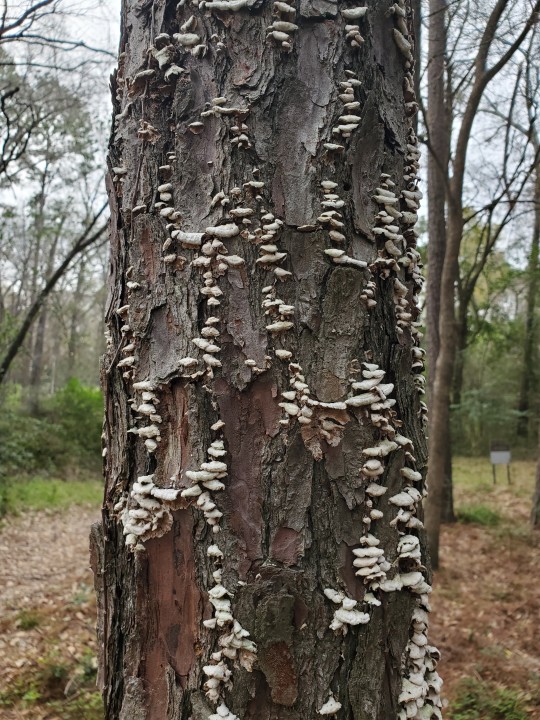
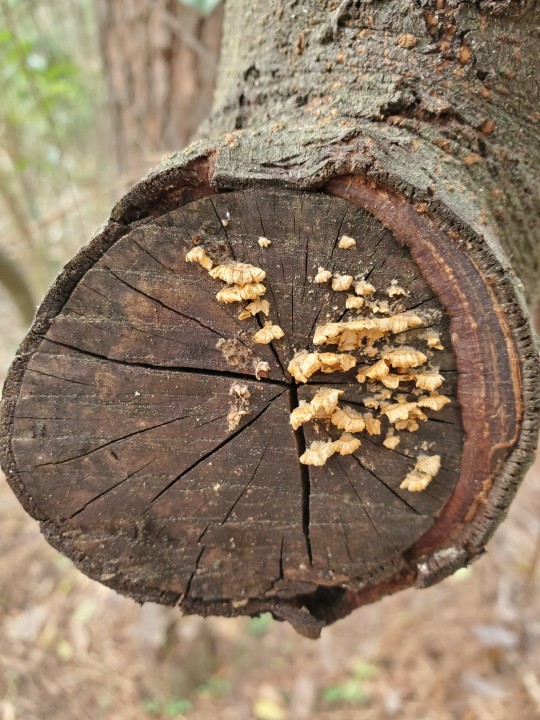
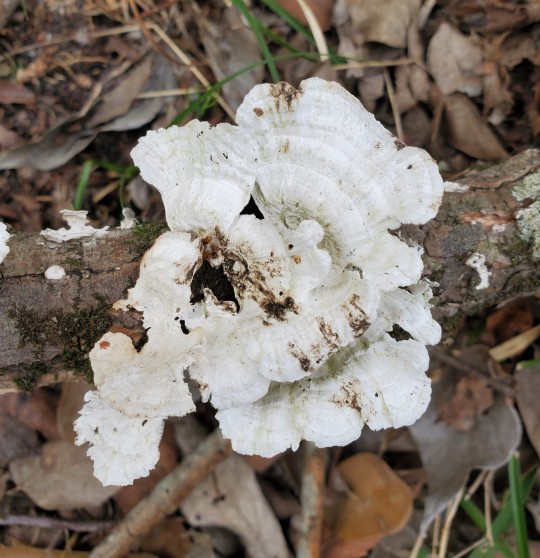


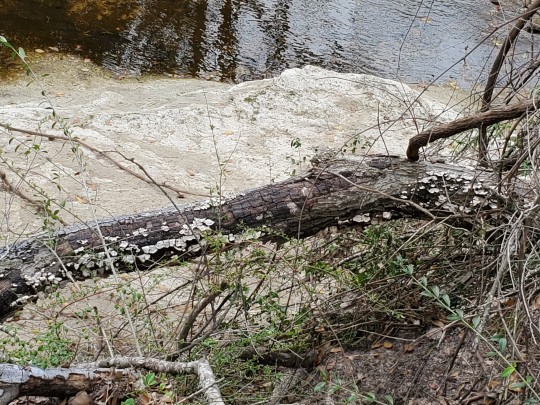
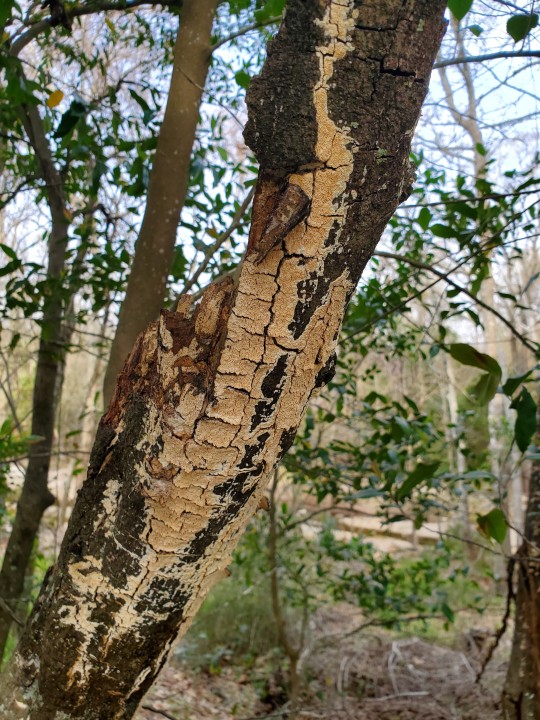


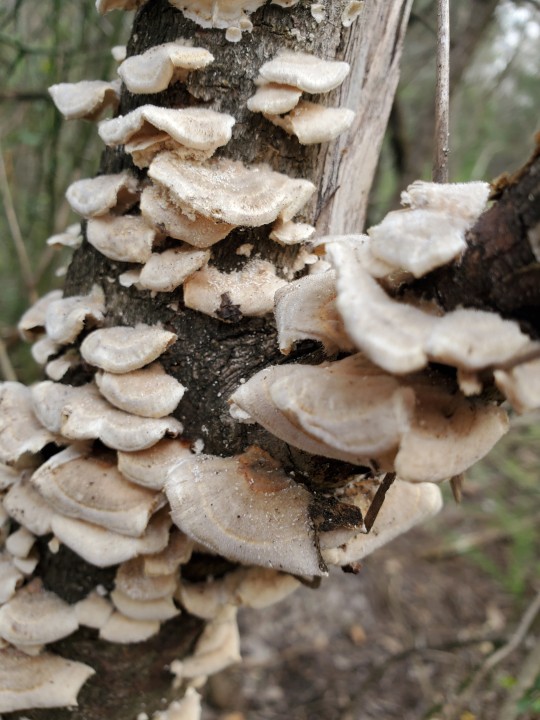
Rot observed on my walk this morning.
Featuring old violet-toothed polypore 》 Trichaptum biforme, Trametes pubescens (no common name), and some others I could not identify.
I'm disheartened by the state of the trails. A lot of old trees have been cut away since last I was there and I saw more marked for removal, active hosts that I've watched feed the local fungi for years now. I wish I knew how they were being disposed of.
Not only that but the entrance used to be lined with wild dewberry shrubs that have been completely torn up. The vegetation was thick and diverse and now its just short grasses. I thought maybe there would be enough root for them to bounce back but it doesn't look like that's gonna happen. I did find some more flowering farther up the main trail, but nowhere near the amount there was before.
And on top of all this, the bluebonnets and redbuds are already blooming a month early for their season and I cannot describe the sense of foreboding this brings me. Its fine. Everything is fine. We are all going to be just fine.
Southeast Texas, 28 Feb. 2024
#amatuer mycology#mushroom hunting#mushrooms#mycology#fungi#mushrooms of texas#texas mushrooms#wild fungi#fungi of texas#fungarium#foraging#mushroom#wild mushrooms#mushroom identification#species identification#white rot#crust fungus#bracket fungi#trametes pubescens#trametes genus#violet toothed polypore#decay#rot#special interest
8 notes
·
View notes
Text
Reasons to live | Ruth Awad
Because if you can survive
the violet night, you can survive
the next, and the fig tree will ache
with sweetness for you in sunlight that arrives
first at your window, quietly pawing
even when you can’t stand it,
and you’ll heavy the whining floorboards
of the house you filled with animals
as hurt and lost as you, and the bearded irises will form
fully in their roots, their golden manes
swaying with the want of spring—
live, live, live, live!—
one day you’ll put your hands in the earth
and understand an afterlife isn’t promised,
but the spray of scorpion grass keeps growing,
and the dogs will sing their whole bodies
in praise of you, and the redbuds will lay
down their pink crowns, and the rivers
will set their stones and ribbons
at your door if only
you’ll let the world
soften you with its touching.
18 notes
·
View notes
Text

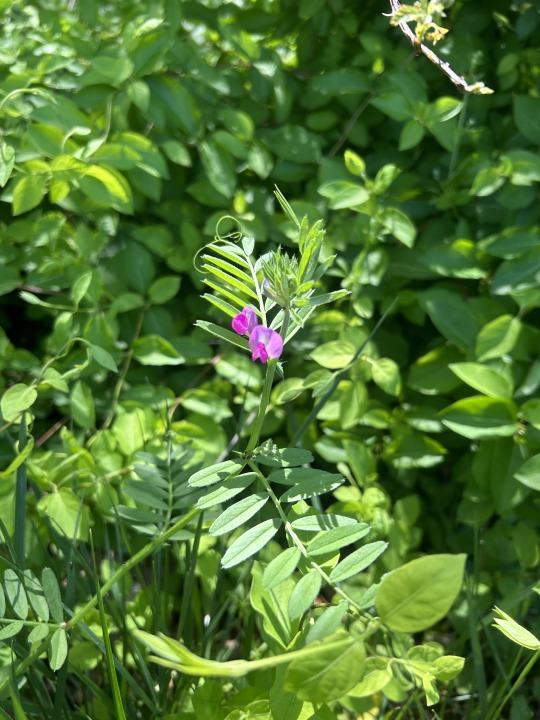
vetch!!! (Vicia sativa) (starring: one single wonderfully tiny ant)
vetch is an annual plant that grows in disturbed soil pretty much everywhere on earth OKAY HERES THE COOL PART it fertilizes the soil!!!
every plant needs loads of nitrogen its like The most important nutrient partly bc its one of the only ones that can just wash away with water even in healthy soil and also bc its in like Every Single Molecule in their entire body
and nitrogen is 70% of the air!!! but in the air it exists as two atoms stuck together and the plants cannot munch on that theyre picky okay. but some kinds of bacteria (and also lightning strikes??? which is so cool i love that) can split the atoms apart and put them in a form that the plants LOVE to eat - thats how nitrogen ends up in the soil, when those bacteria die.
but thats not rlly enough on its own 0.0 so some plants (like vetch, my bestie) pretty much just invented farming. like they have little nodes on their roots where they keep the bacteria safe and feed them and take care of them so they can grow and make so much nitrogen that they can give plenty to the plant - and then when the plant dies the soil is fertilized with loads of new nitrogen :3
plants that do this are called nitrogen fixers and they usually thrive in awful degraded soil with no nutrients where nothing else can grow- bc they can just eat from the fucking atmosphere!!!!! theyre SO important for building and feeding soil
vetch is rlly good at doing this so farmers like to plant big fields of it as fertilizer for whatever they plant next. u can do the same thing in a small garden with beans and peas if you leave them in the garden after they die, or plant nitrogen fixing trees and shrubs like redbuds and goumi berries so you can use cuttings from them to feed the soil!!! also clovers i love clovers sm
btw vetch is very much edible do go eat some. never tried it personally but lots of ppl have for thousands of years soooo yeah
6 notes
·
View notes
Text

I never planted four o’clocks in the front yard. I guess the birds did that. And in the one hand, it’s possible that if I’d trimmed the suckers on the redbud it might not be dead now but on the other hand I couldn’t have trimmed the suckers in the circumstances and the fact that they are here now means that the roots are still alive. I will take the win. I neglect my yard and it still hands me joy for free.
Also, the friend who hosts game day has carpet so I went barefoot (except for the compression sock) all afternoon for the first time since I started walking again. A good day.
4 notes
·
View notes
Text
Last summer I took advantage of my break from teaching by enjoying long, daily walks around my neighborhood. I indulged my mind and body in the blueness, stillness, and leafiness that is North Carolina in June and July. It’s truly astounding how many leaves a willow oak can cram into one tiny piece of sky.
On my walks, the yard of one house stuck out. It was unlike any yard I’ve seen around my city or in any of the other cities in the United States, Canada, and Australia where I’ve lived. It is a forest yard. Nearly a dozen large trees are interspersed amid a dense stand of saplings and shrubs. That summer, leaf litter covered the ground. The top of the house was only visible if I craned my neck to see down the paved driveway, itself narrowing and crumbling as roots, lichens, and fungi worked their inexorable magic.
Depending on your perspective, the house with the forest yard could be seen either as an eyesore — and the scariest place to trick-or-treat — or, as in my case, the most splendid place imaginable.
At this point, I should probably mention that I’m an urban ecologist and that the forest yard makes my heart flutter at the possibility and hope of nature in cities.
I looked at aerial images for the area, and they revealed that the trees around that home, which haven’t been actively “managed,” are about 50 years old. Over that time the forest yard has accumulated a bewildering array of species and ecological interactions. Its tulip poplars, walnuts, cedars, redbuds, pines, and willow oaks have soaked up the atmosphere’s carbon dioxide and turned it into much-needed habitat for wildlife: butterflies, bees, and other insects; lizards, snakes, and turtles; frogs and toads; birds; and mammals. It’s home to a multitude of soil invertebrates and fungi that keep the business side of an ecosystem — aka decomposition — going. All the species that share this shady third-of-an-acre lot are intertwined in a complex tangle of relationships that keeps them fed and feeding on one another, interdependent to varying degrees for their life and livelihood.
And all of this exists amidst a matrix of roads, single-family and multiplex housing, commercial plazas, light industry, and high rises that make up a medium-sized city in the Southeast. The forest yard is a little island of nature in a nearly lifeless sea of concrete, asphalt and lawn.
But, to my inexhaustible surprise, that sea of concrete, asphalt, and lawn is not as empty as we tend to assume. Very far from it. Places of dense human habitation are also where many species reside, including some that are threatened. A recent analysis of the birds and plants that occur in 147 cities across the globe revealed that the sampled cities were home to 2,041 bird species — about one-fifth of Earth’s total avian diversity — and 14,240 plant species. These include 36 bird and 65 plant species threatened with global extinction.
0 notes
Text
D:
punished for moving redbud for the 4th time in 4 years:
moved plants out of the space where I wanted to put it
dug a bigger hole in new location for redbud
spend 1-2ish hours digging redbud out, getting as much of the roots as possible (not using a shovel due to mystery wires in the yard, garden fork is tool of choice today)
celebrate getting it out without breaking any branches
move it over to its new home
breaks into 3 pieces, after a light bonk on the fence, putting it into the hole
...
still can't believe it happened.
taped back it up, desperately hoping for a miracle that the cambium will reconnect and that it will survive the transplant. ahhh wishful thinking
#gardening#redbud#its probably gonna die#double plant torture#moving and double grafting#no way its gonna survive#XD trying anyways
1 note
·
View note
Text
Because if you can survive
the violet night, you can survive
the next, and the fig tree will ache
with sweetness for you in sunlight that arrives
first at your window, quietly pawing
even when you can’t stand it,
and you’ll heavy the whining floorboards
of the house you filled with animals
as hurt and lost as you, and the bearded irises will form
fully in their roots, their golden manes
swaying with the want of spring—
live, live, live, live!—
one day you’ll put your hands in the earth
and understand an afterlife isn’t promised,
but the spray of scorpion grass keeps growing,
and the dogs will sing their whole bodies
in praise of you, and the redbuds will lay
down their pink crowns, and the rivers
will set their stones and ribbons
at your door if only
you’ll let the world
soften you with its touching.
Reasons to Live by Ruth Awad
0 notes
Text
Introduction to Invasive Plants
We have discussed invasive species in general as well as some invasive plants, and today we will explore invasive plants in more detail. In future articles, we will examine specific examples of invasive plants in Pennsylvania. Four plants are being phased out of nurseries and will no longer be allowed to be planted. Japanese Barberry and burning bush were phased out at the end of 2022. The other species of invasive plants in this series that Pennsylvania has added to a noxious weeds list are flowering pear trees and four species of privets.
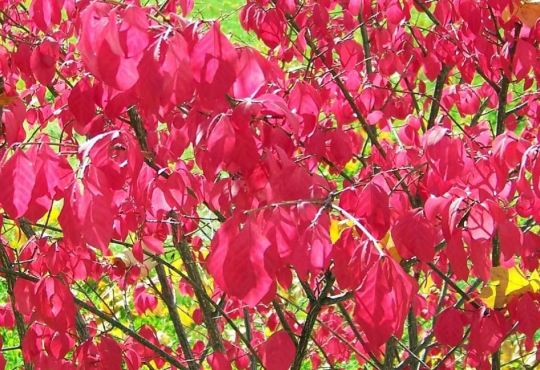
Introducing 4 Invasive Plant Species
Japanese Barberry is a popular ornamental plant used in landscapes across the east coast of the United States. However, as plant health care experts have become more familiar and knowledgeable, the plant has been identified as highly invasive. In addition, the shrub, known for its striking color during fall, is a host for several human diseases, including Lyme disease.
Burning bush is a flowering plant native to China, Japan, and Korea. The plant is famous for its vibrant red foliage during the fall. Burning bush is an invasive species because the plant creates extremely dense thickets and complex root systems, crowding out many native plant species.
Flowering pear trees, such as the Callery Pear, will be another banned plant species in Pennsylvania as of Feb. 10, 2024. Another species popular for its appearance, Callery Pear is similar to Burning bush because the tree proliferates and forms dense thickets, preventing other plants from growing.
Four species of privets, Chinese, European, Japanese, and border privets, can seed into the wild environments and prevent native plants needed by native wildlife and pollinators from growing.
Advantages of Native Plant Species
Native plant species offer advantages over invasive plants in a landscape. One advantage is that native plants are adapted to local soils, climates, and conditions. As a result, native plants will persist through tough climate conditions like frost and drought. Another benefit is that in their environment, native plants require less maintenance, such as water and soil amendments.
Examples of Pennsylvania Native Species
Some examples of native species of plants in Pennsylvania are as follows:
Trees: Eastern Redbud, Dogwood, and Red Maple
Shrubs: Azaleas, New Jersey Tea, and Smooth hydrangea
Perennials: Virginia bluebells, Black-eyed Susan, and Butterfly milkweed
Next month we will discuss the Japanese Barberry in more detail: what the plant looks like, what makes the species invasive, the potential for harm, and control methods and solutions.
Contact Burkholder PHC for Invasive Plant Treatment & Removal
If you are concerned about invasive plants in your landscape or want more information because these plants are affecting your property, contact Burkholder PHC. We provide a free evaluation by our highly experienced, qualified plant health care experts to help remove and control invasive plants and control any adverse effects. Contact Burkholder PHC today for a free consultation.
Blog is originally published at: https://www.burkholderphc.com/introduction-invasive-plants/
It is republished with the permission from the author.
#invasive plants#plant health care services#plant health care#Invasive Plant Species#Advantages of Native Plant Species
0 notes